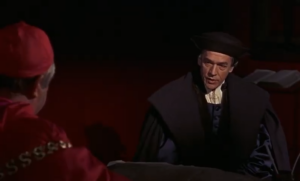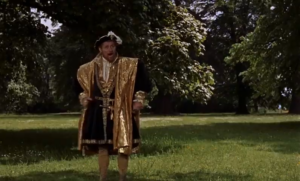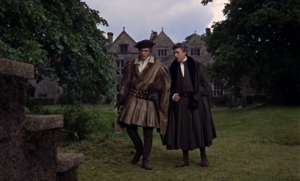Rating: 4 out of 5





How does a person decide between choosing a king that they must follow or the religious teachings and being faithful to God and his holy book? On one side, there is a king who wants to divorce his wife to marry his mistress, but it is against the church. On the other side, faith and the holy book tell you that the king is wrong, and to go against it is going against everything you believe in. This is the predicament that Sir Thomas More found himself in and ultimately cost him everything and his life. The dude had to report and serve King Henry VIII. King Henry VIII had more wives than some movie stars. This isn’t about Henry VIII but Sir Thomas More.
The first time I had ever heard of Sir Thomas More was watching the HBO show, the Tudors. Not a great and most accurate way to learn about someone, but it is a start. Here is a little bio on Sir Thomas More from the “all-knowing” pages of Wikipedia. Sir Thomas More was an English lawyer, judge, social philosopher, author, statesman, and noted Renaissance humanist. He also served Henry VIII as Lord High Chancellor of England from October 1529 to May 1532. He opposed the Protestant Reformation, directing polemics against the theology of Martin Luther, Huldrych Zwingli, John Calvin, and William Tyndale. More also opposed Henry VIII’s separation from the Catholic Church, refusing to acknowledge Henry as supreme head of the Church of England and the annulment of his marriage to Catherine of Aragon. The last part was the most significant “crime” against him. After refusing to take the Oath of Supremacy, he was convicted of treason and executed. On his execution, he was reported to have said: “I die the King’s good servant, and God’s first.” More was declared a patron saint in 2000.
A Man for All Seasons is a British biographical drama film based on Robert Bolt’s 1960 play of the same name. Directed by Fred Zinnemann, the film and play both depict the final years of Sir Thomas More (Scofield). King Henry VIII (Shaw) is in power and wants to marry Anne Boleyn (Redgrave). The king’s current wife, Catherine of Aragon, is unable to bear him a son and heir, so the dude wants out of his marriage to marry Anne. He wants to divorce Catherine but, other than the Pope, the main impediment is Sir Thomas More, a pre-eminent legal authority and devout Catholic. Everyone and their mama try to convince More to let the divorce happen. Even Cardinal Wolsey (Welles) tries, but More is steadfast in his views. King Henry VIII even rolls through to More’s home to convince him is a sad display of power, even making More Lord Chancellor, one of the highest positions in government. Yet, More will not budge from his views and resigns out of protest against the king’s plans to go ahead with the divorce. Thinking that he is out of the public eye, a plot begins to bring More down for treason from his worse enemies.

First, let’s give a shout-out to Sir Thomas More and him staying true to who he was and how he did things. The homeboy stood his ground even when he saw his enemies close in around him and betray him. When he was bribed with a silver cup, homeboy threw it in the river when the boatsman jumped in because he thought he was crazy for doing it. Another scene is when King Henry VIII rolled up in a grand fashion to his house and complained like no other. More is the calmest of voices just listened and stood his ground. Mostly, the whole film shows how people stabbed More in the back just because they didn’t have the balls to stand up to a whiny king. Time would show that King Henry VIII had like six or seven wives. The final scene during the trial was simply an art form as he told everyone off even though he knew he would be executed.
Now the cinematography and costume design was a nice sight to look at. With the cinematography, certain scenes just made the movie pop out. The first one was when King Henry VIII rolled up to More’s house. You want to talk about having so many boats for one dude’s entourage. The dude came in hot. The court scene was also well shot. It had this grand environment, but the use of dull colors gave it the sense that it wasn’t a happy place to be in. Let’s talk about them costumes. Nothing said the 16th century than those costumes. Frills on the arms, not a color in sight besides the king and church, if you’re a cardinal. Besides that, all those costumes were dull and pretty sad. Where the color at y’all?
As far as the acting goes, the one who needs to be talked about is Paul Scofield as Sir Thomas More. Scofield displayed such calmness, grace, and fervor. He raised his voice when he needed to. He was stern and unwavering during other moments. Even when More was in jail, Scofield still showed More having wit and charm during the face of execution. Scofield laid it all out for the world during the court scene to show how great he is.

Robert Shaw definitely made his mark in this film as the spoiled as Henry VIII. The one scene where Shaw showed almost all of his range was his conversation with More. Shaw was LOUD as the king who went on a fiery temper tantrum to being calm and friendly, to being charming, and then back to having a temper tantrum where everyone could hear him. When he didn’t get the answer he wanted, he just rolled out and left his crew behind.
A Man for All Seasons is a good movie that is carried by lead actor Paul Scofield. Homeboy brought it and carried this movie that was interesting to see with all the backstabbing against a man who put his faith first and king second. A move that ultimately cost him his life. The ultimate question is if a higher figure asks you to do something against your values, would you stand firm or be part of the crowd even if you are killed.